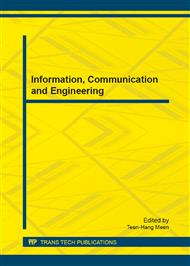[1]
W.H. DeLone and E.R. McLean, The DeLone and McLean model of information systems success: A ten-year update. Journal of Management Information Systems. 19 (2003) 9-30.
DOI: 10.1080/07421222.2003.11045748
Google Scholar
[2]
F.D. Davis, R.P. Bagozzi, and P.R. Warshaw, User Acceptance of Computer Technology: A Comparison of Two Theoretical Models. Management Science. 35 (1989) 982-1003.
DOI: 10.1287/mnsc.35.8.982
Google Scholar
[3]
W.H. DeLone and E.R. McLean, Information systems success: The quest for the dependent variable. Information Systems Research. 3 (1992) 60-95.
DOI: 10.1287/isre.3.1.60
Google Scholar
[4]
M. Igbaria, End-user computing effectiveness: A structural equation model. Omega. 18 (1990) 637-652.
DOI: 10.1016/0305-0483(90)90055-e
Google Scholar
[5]
L.F. Pitt, R.T. Watson, and C.B. Kavan, Service quality: A measure of information systems effectiveness. MIS Quarterly: Management Information Systems. 19 (1995) 173-185.
DOI: 10.2307/249687
Google Scholar
[6]
A. Bhattacherjee, Understanding information systems continuance: An expectation-confirmation model. MIS Quarterly: Management Information Systems. 25 (2001) 351-370.
DOI: 10.2307/3250921
Google Scholar
[7]
J. Etezadi-Amoli and A.F. Farhoomand, A structural model of end user computing satisfaction and user performance. Information and Management. 30 (1996) 65-73.
DOI: 10.1016/0378-7206(95)00052-6
Google Scholar
[8]
P.B. Seddon and M.Y. Kiew, A partial test and development of DeLone and McLean's model of IS success. Australian Journal of Information Systems. 4 (1996) 90-109.
Google Scholar
[9]
H. Lee, Y. Lee, and D. Yoo, The determinants of perceived service quality and its relationship with satisfaction. Journal of Services Marketing. 14 (2000) 217-231.
DOI: 10.1108/08876040010327220
Google Scholar
[10]
R.N. Bolton and K.N. Lemon, A dynamic model of customers' usage of services: Usage as an antecedent and consequence of satisfaction. Journal of Marketing Research. 36 (1999) 171-186.
DOI: 10.1177/002224379903600203
Google Scholar
[11]
A.W. Gatian, Is user satisfaction a valid measure of system effectiveness? Information and Management. 26 (1994) 119-131.
DOI: 10.1016/0378-7206(94)90036-1
Google Scholar
[12]
J. Iivari, An empirical test of the DeLone-McLean model of information system success. Data Base for Advances in Information Systems. 36 (2005) 8-22.
DOI: 10.1145/1066149.1066152
Google Scholar
[13]
A. Srinivasan, Alternative measures of system effectiveness: Associations and implications. MIS Quarterly: Management Information Systems. 9 (1985) 243-253.
DOI: 10.2307/248951
Google Scholar
[14]
D.E. Leidner, Mexican executives' use of information systems: An empirical investigation of EIS use and impact. Journal of Global Information Technology Management. 1 (1998) 19-36.
DOI: 10.1080/1097198x.1998.10856228
Google Scholar
[15]
W. Cheung, M.K. Chang, and V.S. Lai, Prediction of Internet and World Wide Web usage at work: A test of an extended Triandis model. Decision Support Systems. 30 (2000) 83-100.
DOI: 10.1016/s0167-9236(00)00125-1
Google Scholar
[16]
V. McKinney, K. Yoon, and F. Zahedi, The measurement of Web-customer satisfaction: An expectation and disconfirmation approach. Information Systems Research. 13 (2002) 296-315.
DOI: 10.1287/isre.13.3.296.76
Google Scholar
[17]
G.C. Moore and I. Benbasat, Development of an instrument to measure the perceptions of adopting an information technology innovation. Information Systems Research. 2 (1991) 192-222.
DOI: 10.1287/isre.2.3.192
Google Scholar
[18]
W.W. Chin and T. Frye, PLS Graph (Version 2.91.03.04). (1996).
Google Scholar
[19]
J.C. Anderson and D.W. Gerbing, Structural Equation Modeling in Practice: A Review and Recommended Two-Step Approach. Psychological Bulletin. 103 (1988) 411-423.
DOI: 10.1037/0033-2909.103.3.411
Google Scholar
[20]
G. Gable, D. Sedera, and T. Chan. Enterprise systems success: a measurement model. 2003: Citeseer.
Google Scholar
[21]
W.H. DeLone and E.R. McLean, Measuring e-commerce success: Applying the DeLone and McLean Information Systems Success Model. International Journal of Electronic Commerce. 9 (2004) 31-47.
DOI: 10.1080/10864415.2004.11044317
Google Scholar


